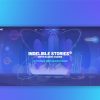If customers are the core of your business, it’s time to implement a successful Customer Journey Map. Find out how to do it and improve the experience from start to finish!
Nowadays the key for any brand is to generate value for its customers. However, sometimes it is difficult to find the best way to do it.
The first thing to do if you really want to know how your customers feel about your firm is to analyze the buying cycle from their perspective, not yours.
It is obvious?
Well, maybe not so much. Many times you go through all the steps a customer goes through before making a purchase, but you don’t take into account how they feel, what their expectations are or what they think of your business after the cycle is over.
So pay close attention to this article and find out how using a Customer Journey Map can help you and learn how to design your own. Take note!
What is the Customer Journey and how important is it?
It is a Design Thinking tool that allows you to capture in a map, each of the stages, interactions, channels and elements that a customer goes through during the entire buying cycle.
Nowadays, with the power that Social Media have acquired, our advice is to extend this study to the post-sales level. The customer who has already bought a product from you, how does he/she talk about the brand in media, does he/she recommend it, does he/she have negative impressions?
90% of dissatisfied consumers feel that they have no space to give their opinion or believe that it will not be important, so why don’t you give it to them? Send an automatic Email with a special post-purchase discount, and take the opportunity to ask them how their experience was, they will not only feel that their opinion matters, but they will also be rewarded! With Doppler you can send Email Automation Campaigns totally free, create your account and try it!
Do Email Marketing and guide the user through the Customer Journey
This set of moments that each user goes through is of vital importance for your business. The perception that the customer has of your company in each of them can determine the purchase of your product or that of your competitors.
So the tool will help you, not only to know each instance that the user goes through during his life cycle, but also to know exactly where, when and how to act if your business is chosen when making a purchase.
The key then of this diagram is that it is not an objective analysis of each of the points that make up the customer’s life cycle, but the focus is on how the customer feels about the brand in each of them.
Sounds interesting, doesn’t it?
How to create a Customer Journey Map
There is no one model that can be applied to all businesses, as each product or service demands a different customer life cycle.
On Innokabi’s blog you can see a Customer Journey through an example based on a Restaurant.
First, a graph is drawn in which the X Axis shows the phases through which the customer goes through over time and in the Y Axis, it is defined how he feels the experiences, from the most negative, in red, to the most positive, in green.
The example considers the most critical stages, from the moment the customer enters the store until he pays. Then, in order to know their experience in each phase, the idea was to ask them before leaving how they felt in each one of them.
Once all this is captured in the graph, each point is connected by a line and a map of the customer’s experience is generated.
Another data to consider, in addition to the phases and the feelings or sensations of the customers, can be the critical points of the business, since they can determine whether or not the purchase is completed.
So, in the graph that you can see below you can notice:
1) Positive points: Entrance to the store, food and eating dessert.
2) Negative points: Table selection and payment.
3) Critical points (stops): The first look at the restaurant, the menu and the food.
What is the Customer Journey Map and how to build one.
Source: Innokabi.
Next, we analyze how the negative points can be improved and what is happening with the critical ones, to determine how customers feel in these key phases and how the value of their experiences could be enhanced.
Finally, the interactions in which the company takes part are defined. In this case, they were divided between direct (visible to the customer) and indirect (invisible to the customer).
In short, a complete customer journey map can help you understand and redesign your customers’ experience, align your vision with theirs and build a more effective conversion funnel.


















